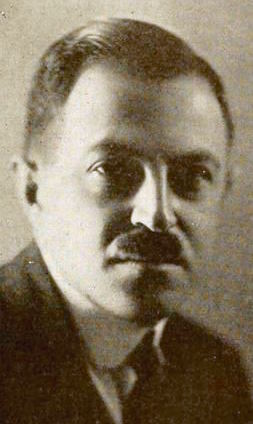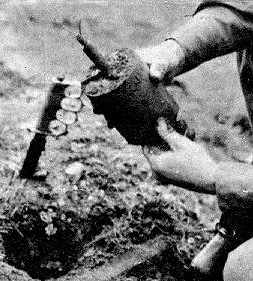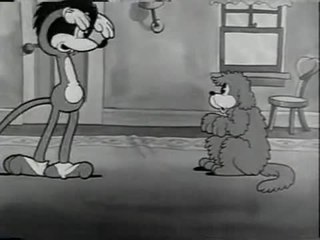
Max Fleischer was a Polish-American animator and studio owner. Born in Kraków, Poland, Fleischer immigrated to the United States where he became a pioneer in the development of the animated cartoon and served as the head of Fleischer Studios, which he co-founded with his younger brother Dave. He brought such comic characters as Koko the Clown, Betty Boop, Popeye, and Superman to the movie screen, and was responsible for several technological innovations, including the rotoscope, the "follow the bouncing ball" technique pioneered in the Ko-Ko Song Car-Tunes films, and the "stereoptical process". Film director Richard Fleischer was his son.

Rebecca Alie O'Connell is an American actress and former model. She is known for her role as Mystique in the original trilogy (2000–2006) of the X-Men film series, as Joan from The Punisher (2004), the dual roles of Laure Ash and Lily Watts in Femme Fatale (2002), and Una Chin-Riley on Star Trek: Discovery (2019) and Star Trek: Strange New Worlds (2022–present). She has also had a recurring role as Alexis Meade on the ABC television series Ugly Betty. Her other major roles include Eve Baird on the TNT series The Librarians, voicing Lois Lane in the DC Animated Movie Universe, and as the host of the reality competition show Skin Wars.
In English-language punctuation, the serial comma, also referred to as the series comma, Oxford comma, or Harvard comma, is a comma placed immediately after the penultimate term and before the coordinating conjunction in a series of three or more terms. For instance, a list of three countries might be punctuated without the serial comma as "France, Italy and Spain" or with the serial comma as "France, Italy, and Spain". The serial comma can serve to avoid ambiguity in specific contexts, though its employment may also generate ambiguity under certain circumstances.

A bouncing bomb is a bomb designed to bounce to a target across water in a calculated manner to avoid obstacles such as torpedo nets, and to allow both the bomb's speed on arrival at the target and the timing of its detonation to be predetermined, in a similar fashion to a regular naval depth charge. The inventor of the first such bomb was the British engineer Barnes Wallis, whose "Upkeep" bouncing bomb was used in the RAF's Operation Chastise of May 1943 to bounce into German dams and explode underwater, with an effect similar to the underground detonation of the later Grand Slam and Tallboy earthquake bombs, both of which he also invented.

The German S-mine, known by enemy Allied Forces as the "Bouncing Betty" on the Western Front and "frog-mine" on the Eastern Front, is the best-known version of a class of mines known as bounding mines. When triggered, these mines are launched into the air and then detonated at about one metre (3 ft) from the ground. The explosion projects a lethal spray of shrapnel in all directions. The S-mine was an anti-personnel mine developed by Germany in the 1930s and used extensively by German forces during World War II. It was designed to be used in open areas against unshielded infantry. Two versions were produced, designated by the year of their first production: the SMi-35 and SMi-44. There are only minor differences between the two models.

An air burst or airburst is the detonation of an explosive device such as an anti-personnel artillery shell or a nuclear weapon in the air instead of on contact with the ground or target. The principal military advantage of an air burst over a ground burst is that the energy from the explosion, including any shell fragments, is distributed more evenly over a wider area; however, the peak energy is lower at ground zero.
A wolverine is a stocky and muscular carnivorous mammal that resembles a small bear.

A bounding mine is an anti-personnel mine designed to be used in open areas. When it is tripped, a small propelling charge launches the body of the mine 3 to 4 feet into the air, where the main charge detonates and sprays fragmentation at roughly waist height.

Ultimate Wolverine vs. Hulk is a comic book miniseries, published by Marvel Comics. The series is set in one of Marvel's shared universes, the Ultimate Universe. It was written by Lost co-creator Damon Lindelof, and illustrated by artist Leinil Francis Yu and colorist Dave McCaig. The title characters square off after Wolverine is contracted by Nick Fury to assassinate the Hulk, who is known to be residing in Tibet. The series features cameos by other Ultimate characters, as well as the introduction of Ultimate She-Hulk.

Ugly Betty is an American comedy-drama television series developed by Silvio Horta that aired on ABC from September 28, 2006, to April 14, 2010. The series is based on Fernando Gaitán's Colombian telenovela Yo soy Betty, la fea, which has had many other international adaptations. It revolves around the character Betty Suarez, who – despite her lack of style – lands a job at a prestigious fashion magazine. It was produced by Silent H, Ventanarosa, and Reveille Productions partnered with ABC Studios, with Salma Hayek, Horta, Ben Silverman, Jose Tamez, and Joel Fields serving as executive producers. The pilot was filmed in New York City; seasons one and two were filmed in Los Angeles and seasons three and four were filmed in New York City.

The bouncing ball is a virtual device used in motion picture films and video recordings to visually indicate the rhythm of a song, helping audiences to sing along with live or prerecorded music. As the song's lyrics are displayed on the screen in a lower third of projected or character-generated text, an animated ball bounces across the top of the words, landing on each syllable when it is to be sung.
"When You Were Mine" is a song written and released by Prince on his 1980 album, Dirty Mind. Though not released as a single, the song received a promotional 12" release. "When You Were Mine" was later the B-side for Prince's "Controversy" single in 1981.

Making Stars is a 1935 Fleischer Studios animated short film, starring Betty Boop. The short contains one of the earliest clear examples of the oriental riff that would become popular as a leitmotif for Asian culture following the release of the 1974 song Kung Fu Fighting.
Betty Boop and Little Jimmy is a 1936 Fleischer Studio animated short film, starring Betty Boop and featuring newspaper comic strip character Little Jimmy.
Betty and Bettie are common diminutives for the feminine given names Elizabeth and Bethany.

"Fight Club" is the twentieth episode of the seventh season of the science fiction television series The X-Files. It premiered on the Fox network in the United States on May 7, 2000. It was written by series creator Chris Carter, directed by Paul Shapiro, and featured a guest appearance by Kathy Griffin. The episode plot serves as a "Monster-of-the-Week" story, which is unconnected to the series' wider mythology. "Fight Club" earned a Nielsen household rating of 6.9, being watched by 11.70 million people in its initial broadcast. The episode received mostly negative reviews from television critics.

Elizabeth Burbridge was an American screenwriter and actress, best known for her Western screenplays.

"Nation X" is a 2009–2010 crossover storyline published by Marvel Comics featuring the X-Men. Published in the aftermath of the "Utopia" storyline and dealing with the return of Magneto, the story appeared across several different books, including Uncanny X-Men #515–522, Nation X #1–4 and X-Men: Legacy #228–230. Its writers include James Asmus, Matt Fraction, Grace Randolph, Scott Snyder, Simon Spurrier, and Chris Yost, and its artists include Leonard Kirk, Mike Allred, Terry Dodson, Greg Land and Whilce Portacio.
Little Annie Rooney is a short animated film that is part of the Fleischer Studios Screen Songs series. It is based on the popular song Little Annie Rooney and uses it in the soundtrack. The chorus says:
Spider-Girl is the code name of several fictional characters in comic books published by Marvel Comics. The most prominent version and first to receive an ongoing series is Mayday Parker from the MC2 universe, the second version is Anya Corazon, the third version is Gwen Warren, and the fourth version is Christina Xu, the latter three from the Earth-616 universe. Several alternate reality incarnations of the character have additionally received notoriety, including the Ultimate Spider-Girl, Ashley Barton, Betty Brant, April, Penelope and Petra Parker, and Charlotte Morales.












